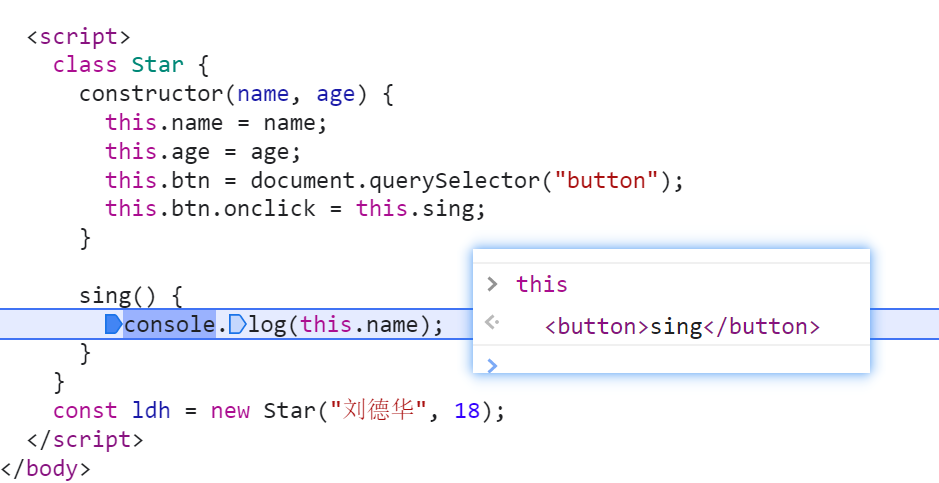JS深入学习笔记 - 第二章.类和对象
3.类和对象
3.1面向对象
这里顺带提一句学习JAVA时,老师说的面向对象和面向过程的区别:
面向过程:强调做什么事情,具体什么步骤。举个把大象放进冰箱的例子:
- 打开冰箱门
- 把大象放进冰箱
- 关上冰箱门
面向对象:强调的是做动作的主体(称之为对象)
- 冰箱:打开操作
- 冰箱:放的操作(放的可以是大象也可以是老鼠)
- 冰箱:关闭的操作

面向对象的思维特点:
- 抽取(抽象)对象共用的属性和行为封装成一个类(模板)
- 对类进行实例化,创建类的对象(具体的东西)
3.2对象
现实中:对象是一个具体的事物,比如一本书、一辆车、一个人。
在js中:对象是一组无序的相关属性和方法的集合,所有的事物都是对象,如:字符串、数组、数值、函数等。
对象是由属性和方法组成的:
- 属性:事物的特征,在对象中用属性来表示
- 方法:事物的行为,在对象中用方法来表示
3.3 类
ES6中新增了类的概念,可以使用class关键字来声明一个类,之后以这个类来实例化对象。
类抽象了对象的公共部分,它泛指某一大类,
对象特指**某一个,通过类实例化一个具体的对**象。
类的本质:
- class本质还是function
- 类所有的方法都定义在类的prototype属性上
- 类创建的实例里面也有__ proto__ 指向类的prototype原型对象
- 所以ES6的类的绝大部分功能。ES5都可以做到,新的class的写法只是让对象原型的写法更加清晰、更面向对象编程的语法。
- 所以ES6的类其实就是语法糖
class Father { } console.log(Father instanceof Function); //true //(1)类有原型对象prototype console.log(Father.prototype); //(2)类的原型对象prototype 里面有 constructor 指向类本身 console.log(Father.prototype.constructor); //(3)类可以通过原型对象添加方法 Father.prototype.speak = function () { console.log("speak"); }; //(4)类创建的实例对象有 __proto__ 指向类的原型对象 const zooey = new Father(); console.dir(zooey.__proto__ === Father.prototype); //true
3.4创建类和实例化对象
//创建类 class Star { //共有属性放在constructor中 constructor(uname, age) { this.name = uname; this.age = age; } } // 利用类实例化对象 const ldh = new Star("刘德华", 19); const syz = new Star("孙燕姿", 18); //打印查看 console.log(ldh); console.log(syz);
- 注意:
- 通过class关键字创建类,类名首字母大写。
- 类里面有一个constructor函数,可以接收传递过来的函数,同时返回实例对象。
- 只要使用new生成实例时,就会调用constructor函数,如果我们不写这个函数, 类也会自动生成这个函数。
3.5类中添加方法
//创建类 class Star { //共有属性放在constructor中 constructor(uname, age) { this.uname = uname; this.age = age; } sing(song) { //方法中可以this.使用实例属性 console.log(this.uname + "会唱" + song); } } // 利用类实例化对象 const ldh = new Star("刘德华", 19); const syz = new Star("孙燕姿", 18); //打印查看 console.log(ldh); console.log(syz); ldh.sing("忘情水"); syz.sing("遇见");

注意:
- 类里面的所有函数(方法)不需要写function
- 多个函数方法(包括构造函数)之间不需要用 ',' 分割
4 类的继承
现实中的继承:子承父业,比如我们都继承了父亲的姓。
程序中的继承:子类可以继承父类的一些属性和方法。
4.1使用extends关键字实现继承
//创建父类类 class Father { constructor(name, sex) { this.name = name; this.sex = sex; } money() { console.log(1000); } } // 创建子类并继承父类 class children extends Father { } const oldestSon = new children("伯邑考", "男"); const middleSon = new children("姬发", "男"); son.money();
4.2super关键字
一个错误使用案例:
class Father { constructor(x, y) { this.x = x; this.y = y; } total() { return this.x + this.y; } } class Son extends Father { constructor(x, y) { this.x = x; this.y = y; } } const son = new Son(1, 1); console.log("结果:" + son.total());

此时希望调用父类中的构造函数则需要使用到super
class Father { constructor(x, y) { this.x = x; this.y = y; } total() { return this.x + this.y; } } class Son extends Father { constructor(x, y) { super(x, y); } } const son = new Son(1, 1); console.log("结果:" + son.total()); //结果:2
思考:看到这里不知道你会不会和我有一样的困惑,此时没有super也可以实现 total方法的调用,所以 super存在真正的意义是什么呢
思考案例1:
class Father { constructor(x, y) { this.x = x; this.y = y; } total() { return this.x + this.y; } } class Son extends Father { } const son = new Son(1, 1); console.log("结果:" + son.total());

那么就让我们停下来思考一下:
当我们给Son构造函数传递多个参数的时候,这时,输出的结果就不是我们想要的结果了,此时就必须使用super才能传递正确的参数了。
思考案例2:
class Father { constructor(x, y) { this.x = x; this.y = y; } total() { return this.x + this.y; } } class Son extends Father { } const son = new Son(1, "女", "zooey", 1); console.log("结果:" + son.total());//结果:1女
真正意义上:
利用Son类创建实例son时,我们将实例son的参数传递给Son类的构造函数,
构造函数通过super()调用Father 的构造函数从而给this.x,this.y赋值,
从而使Father类中的total的方法能够找到 this.x,this.y,
从而实现了思考案例1的结果。

没有super时:

super关键字用于访问和调用对象父类上的函数,可以调用父类的构造函数,也可以调用父类的普通函数。
super调用父类的方法:
class Father { constructor(x, y) { this.x = x; this.y = y; } total() { return this.x + this.y; } } class Son extends Father { constructor(x, y, z) { super(x, y); this.z = z; } total() { //子类方法中调用父类方法 return this.z + super.total(); } } const son = new Son(1, 1, 1); console.log("结果:" + son.total());//3
注意:子类的this赋值操作要放在super之后

注意事项:
- 在 ES6 中类没有变量提升,必须先定义类,再实例化对象
- 类里面共有是属性和方法一定要加this使用。
class Star { constructor(name, age) { this.name = name; this.age = age; this.btn = document.querySelector("button"); this.btn.onclick = this.sing; } sing() { console.log(this.name); } } const ldh = new Star("刘德华", 18);
4.3类中this指向
函数中的this一般指向调用者
下面的代码debug执行下,可以看到,sing()方法执行时,this是指向button的。

那么正确的做法是什么呢?
let _this; class Star { constructor(name, age) { _this = this; this.name = name; this.age = age; this.btn = document.querySelector("button"); //注意:因为这里是点击之后再调用,不是立即执行,所以是sing不是sing() this.btn.onclick = this.sing; } sing() { //使用 _this console.log(_this.name); } } const ldh = new Star("刘德华", 18);
总结:在全局声明一个this,然后调用后将它赋值给调用对象。
举一反三:在react中,常用的另一个方法是使用bind绑定this。
class Star { constructor(name, age) { this.name = name; this.age = age; this.btn = document.querySelector("button"); this.btn.onclick = this.sing.bind(this); } sing() { console.log(this.name); } } const ldh = new Star("刘德华", 18);